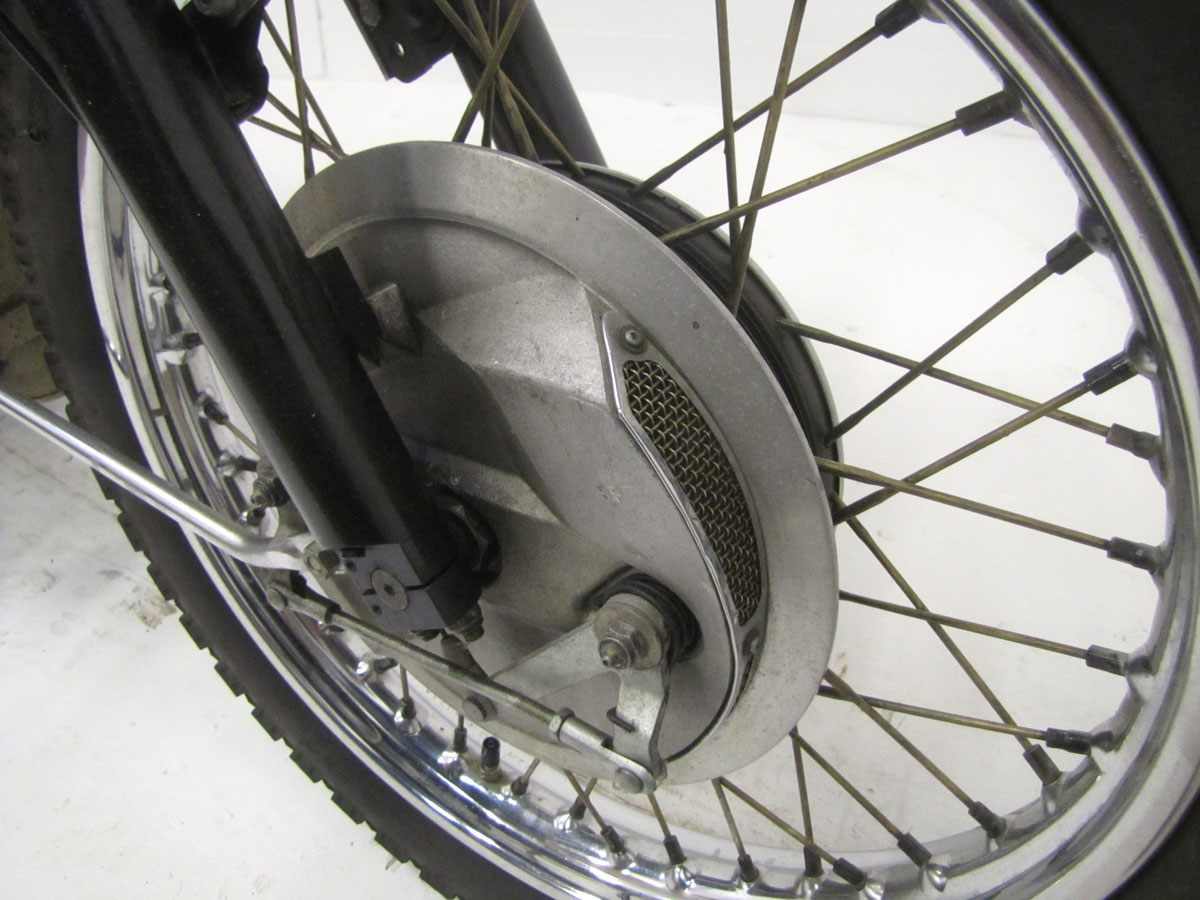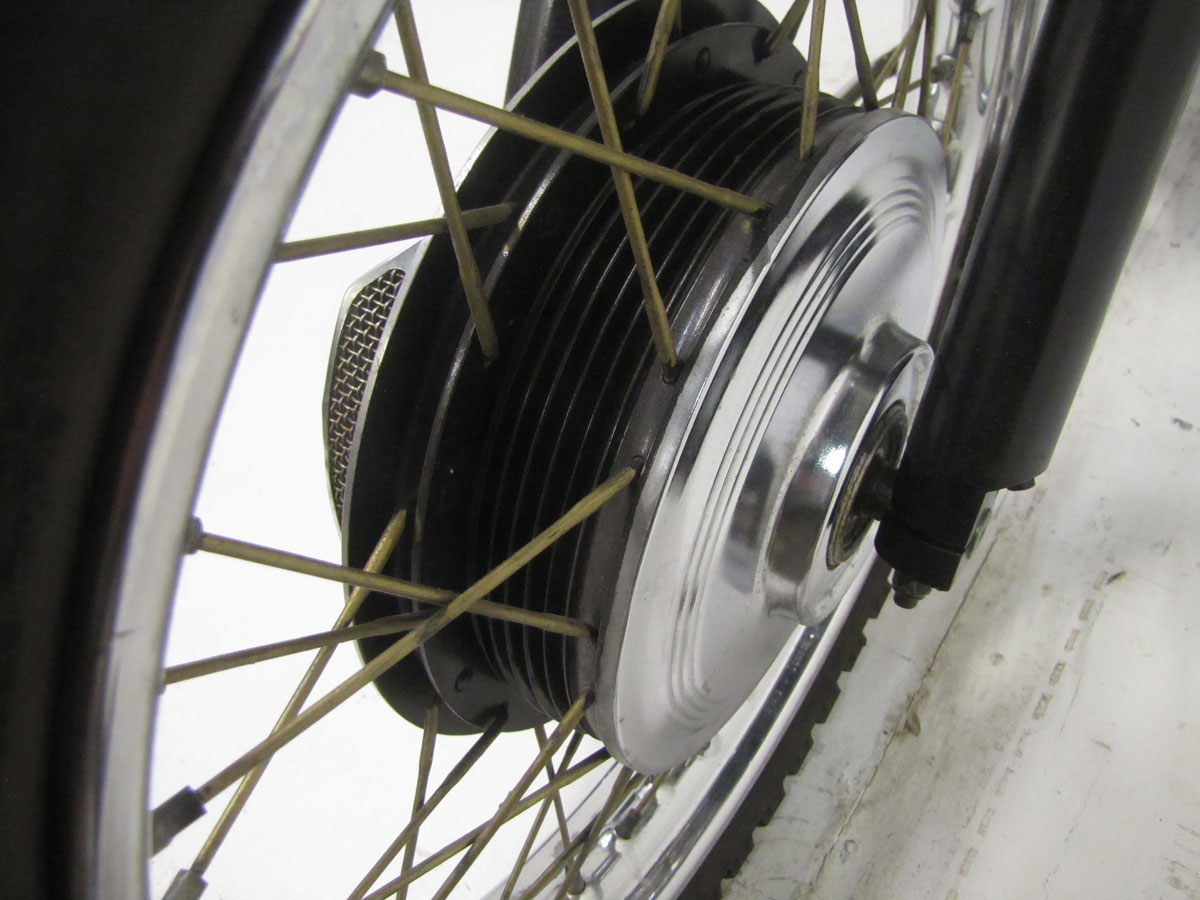
The Thunderbolt was BSA’s single carb 650 twin, made from 1964 to 1972. This 1970 model is a classic, the last before the restyled “oil-in-frame” model appeared.
Birmingham Small Arms was founded in 1862, started making bicycles in the 1880’s and true motorcycles around 1910. Though gone from the scene at the end of the 1972 manufacturing year, BSA had a glorious history and successes even after “the Japanese invasion” of the mid-1960’s. Few realize that BSA was the largest motorcycle manufacturer in the world in the 1950’s, even bought Triumph in 1951! In 1954 BSA swept the top five places in the Daytona 200 on the old beach course. Jeff Smith rode Gold Stars to scrambles and MX championships, Dick Mann won on BSAs as well, even winning the Daytona 200 as late as 1971 on a Rocket III. Much like Triumph they designed machines for basic transportation like the diminutive Bantam, and for high performance in the desert and on dirt tracks, the Hornet.
Some say the 1970 Thunderbolt is the best of that nine year model run. It incorporates dual horns, a one year only detail. The cylinder base studs were strengthened, enlarged to 3/8” diameter. Also, the clutch actuator design was borrowed from Triumph and was a great improvement. Driven by American transportation laws, the brake and clutch lever perches were designed with holes for mirror mounting. Most important, and already mentioned, in 1971 the oil-in-frame design came on completely altering the seating height, and appearance changes were many. Per laws, turn signals were added and most fans felt the classic BSA had met its demise.
BSA’s first twin was the 1946 A7, a Bert Hopwood 500cc design. The unit construction A50, 500cc and A65, 650 cc’s came in 1962 and were BSA mainstays. The A50 and A65 shared a great deal of engine design; the 650 was a bored out 500, in essence. Dual carburetors were used on the higher performance Lightnings, Spitfires and Hornets. The Thunderbolt was easier to keep in tune, and offered more tractable power with its single carb arrangement. BSA’s were typically more flashy than Triumphs with more models using chrome or polished stainless steel fenders. Many BSA fuel tanks had chromed side panels and through the 1960’s glorious transparent plastic tank badges.
BSA was unable to compete well against the Japanese makers and was financially unstable by 1970, bought by the Norton-Villiers-Triumph group in 1971 and made their last motorcycles in 1972. This great BSA was graciously donated to the National Motorcycle Museum by Neil Brandenburger. Several other BSA’s are on display including a newer oil-in-frame model for comparison.
Specifications:
-
- Engine: Overhead Valve Air-Cooled Twin
- Bore & Stroke: 75mm x 64mm
- Displacement: 654 cc’s
- Carburetion: 1 5/32″ Amal Concentric
- Electrics: 12 V Battery/Points
- Horsepower: 42HP
- Starting: Kick Lever
- Primary: Chain Driven
- Transmission: Four-Speed
- Frame: Steel Single Loop
- Suspension: Hydraulic Fork / Twin Shocks, Swingarm
- Brakes: Drum / Drum
- Wheels: 3.25 x 19 / 4.00 x19
- Wheelbase: 56 Inches
- Weight: 480 Pounds
Leave a Reply
Want to join the discussion?Feel free to contribute!





























Thanks for sharing this very interesting story about a great British motorcycle! I visited the museum late in 2015 I think? Might have been 2014. Really impressed with the large number of motorcycles on display!
They were arranged by grouping of manufacturer and type of motorcycle if I remember correctly.
I had planned to stop by the Harley Davidson museum in Milwaukee on the way home but the weather was getting bad so I had to skip Milwaukee and keep moving.
It was my last road trip of the year and a totally spur of the moment idea that really made a great adventure.
I’ve been wanting to return to the museum for a while now but it seems something always pops up and I have to put it off again.
I bought my first motorcycle in 1967. I was 17 then and a junior in high school. It was a Honda Sport 50 and I rode it everywhere.
I had known that I was going to get a motorcycle since the age of six. I dreamed of riding all over the USA and seeing the national parks.
I’m 71 now and I still ride. I have two motorcycles, my trusty 2008 BMW R1200GS Adventure, and my 2014 Harley Davidson ultra classic limited.
I’ve managed to ride my motorcycles to 49 states during my life. The Harley has been to California a time or two, and I rode the BMW to Alaska in 2015.
My first multi-week road trip was on my 1973 Honda 750 Four. The year was 1976, and the destination was Bromont, Quebec Canada. This was during the 1976 Olympics, and the equestrian events were held in Bromont.
The route however was not a direct line from our homes in Kentucky, but a meandering ride on back roads to the east coast then more back roads up the east coast through the original thirteen colonies to the very northern tip of Maine. We visited a few large cities including New York City, and Boston.
There were four motorcycles on that ride, 1968 Harley Davidson Electra Glide, Honda 750 Four, Honda Goldwing, and Suzuki GT 550. We camped all but one night.
The guy who rode the 1968 Harley still owns it, and rides it occasionally but he’s had several new Harleys since then including his 2019 Tri Glide.
I hope to visit the museum in 2022. I think I’ll see if my friend with the Tri Glide is up for another fun ride! He’d love to see the vintage motorcycles in the museum.
Thanks for sharing the history of a great motorcycle,
Bill Bledsoe
Bill,
Thanks for sharing your riding history, friendships, motorcycles in your past.
I highly recommend the Harley-Davidson Museum which is about 3.5 hours from the National Motorcycle Museum. The collection is fantastic and they’ve done a great job of involving visitors in their 120 year history. We are lucky as American motorcyclists to have about half a dozen serious museums to enjoy, most east of the Rocky Mountains. We look forward to your return with some riding buddies, Bill.
Mark
That front fender doesn’t look quite right as it looks high. I wonder if the bike originally had larger diameter front wheel back in the day. I love the old British classic motorcycles.
Love the old BSA and Triumph models. I tried to ride a friends older Triumph with the ride side shift. Really never got the hang of it. Up shifts were Ok but downshifts I would sometimes forget the hit the brake!
Great handling, good power and essentially bulletproof. End feed crank conversion absolutely recommended, as the bronze bush on the timing side of the crank works great for years but eventually wears enough to let the oil pressure suffer, especially when hot, not good for the left hand conrod. I prefer the twin carb 650, more power and the carbs are easy to synchronize if you know your way around carbs and the cylinders/valves have similar compression, not a given. When right, they are perfect – perfect idle, plenty of power. Bore and stroke are actually 75×74, a rare oversquare English design.
one year only for dual horns. I dont even see 1 horn. the single horn was normally mounted on the front motor mount through bolt, right side. Front fender does look wrong. Speedometer missing. Add on driving lights.
Regarding the wheel/tire to fender “fit,” I agree it looks off. When we write up these bikes the spec panel usually gives stock or production wheel and tire sizes. In this case the donor fit a more modern 3.25/85H19 tire which is lower profile than an original 3.25 or 3.50. But if you search the net you will find numerous BSA models from this era with a fender that does not hug the tire as we would expect, like a Triumph would, even with a correct aspect ratio tire. As for the horns, speedo, we have some bikes on loan or donation that are not completely correct. The copy is meant to be informative as possible, reflects what should be there. Glad you all are looking closely!
Don’t we all miss the great bikes we worked on constantly & whet our lifetime appetite for rumbling 2-wheelers on? I had a ‘69 Beezer around ‘72 or ‘73. Not sure of the model, but it was originally equipped with the laughable high pipes you could burn your thigh on.. the original owner claimed he did, and changed it to “TT” pipes and short mufflers that sounded great. He also claimed that made it a Thunderbolt, not that I cared, but it did have two carbs. Never had trouble balancing the carbs, I owned a couple of MGs and an Austin Healy and understood the concept of sticking a length of surgical tubing in your ear and comparing the volume & timbre of the “hiss” of the Venturi at idle and various rpms. Yay me!
All in all, a very good bike for its time. Never cared much for the torque-less offerings from the Land of the Rising Sun in that era. I recently saw a pic of of a Norton Commando for sale at Baxter Cycle equipped with the hideous “scrambler pipes”. Took me back to a time when manufacturers would follow H.L. Mencken’s axiom “No one ever went broke underestimating the taste of the American People”!
Some time later I was getting ready to move across the country and sold the BSA to a friend. He tore it down and bought a hard tail fame, coffin tank, and ridiculous extended forks. Went to work on it. Somehow aesthetic and simultaneously revolting. He found it difficult to ride and sold it. Take that, Peter Fonda!